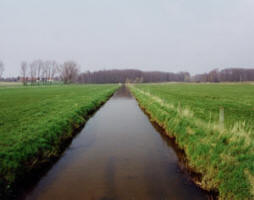 World Water Week: Coordination between industry sectors key to easing water scarcity
World Water Week: Coordination between industry sectors key to easing water scarcity
Manufacturing, agriculture and energy sectors are going to have to coordinate their water use much more efficiently if water scarcity is to be avoided, say experts.
“In the next 30 years global water needs are going to rise by at least 30 percent, putting pressure on vital yet limited resources,” says Richard Connor, lead author of the 2014 UN World Water Development Report.
“By 2050 water needs of the manufacturing sector will rise by a staggering 400 percent,” Connor told IRIN at the September 2014 World Water Week in Stockholm.
“This is going to create immense need for water and pressure on the resource that cannot meet all these needs.”
Kandeh Yumkella, the UN Secretary-General’s special representative onSustainable Energy For All, explained that much of the increasing demand for water will come from developing nations whose populations are earning and consuming more, and moving to cities.
Ninety percent of the world’s urban population increase up to 2050 will be in Asia and Africa, according to the 2014 UN World Urbanization Prospects report. Of the 2.5 billion people who will move to cities in this period, 37 percent will be in India, China and Nigeria.
In the next 30 years world electricity demand will go up by 70 percent and, Yumkella argued, “with 66 percent of the world population expected to be living in urban areas by then, it will push the demand for more energy.” (According to the World Bank, 56 percent of the world’s population currently lives in cities)
The problem, the UN official said, is that “the energy sector in very thirsty.”
According to the International Energy Agency (IEA), in 2012 water use for energy was 583 billion cubic metres; by 2035 that figure is likely to rise by at least 20 percent.
Connor explained that developing countries use most of their water for agriculture and only about 10 to 20 percent for energy. But as countries develop, the demand for energy increases and could account for over half of water usage, leaving less for farmers.
“Ninety percent of global energy production is water-dependent,” Connor said, pointing to hydro-power, and the water used to cool thermal, coal, gas and nuclear power plants. “Even solar electricity generation sometimes uses water to store energy as heat,” he said.
Managing demand
Connor and other experts say better water management will involve establishing clear priorities and coordinated monitoring mechanisms to avoid shortages.
For example, during a major drought in India in 2012, power plants shut down to conserve water for domestic consumption. IEA estimates that at one time or another 600 million were left without power for at least 48 hours.
“When water is scarce the power plants shut down. That’s what happens now when there is no coordination,” Connor said.
In a September 2014 report, the International Crisis Group encouraged Kyrgyzstan, Tajikistan and Uzbekistan, “to develop a modern, corruption-free, and efficient water management systemin the region firewalled from other disputes.”
Nearly 99 percent of Tajikistan’s electricity is generated by hydro-electric plants, and Uzbekistan uses up to 90 percent of the water released by Kyrgyzstan and Tajikistan to irrigate cotton, its main cash crop.
The report pointed to competing demands between agriculture, domestic consumption and the energy sector, and quoted a UN Food and Agriculture Organization expert explaining that “the absence of a shared vision on water security leads to increased risks of competition and conflict over water resources.”
And cooperation means more than reaching out across geo-political borders.
“Water and energy sectors are inter-linked,” IEA executive director van der Hoeven told IRIN. “You have to see to it that both use water as efficiently as they can.”
To achieve better water management, Yumkella said cohesion must be established across water-consuming sectors - especially electricity, water and agriculture.
Silos
He explained that even though the energy and manufacturing sectors were two of the biggest water users, they hardly had any input in deciding a nation’s water policy. Similarly, water experts rarely give input into national energy policies.
“We don’t need to be in these silos any more,” Yumkella said.
An additional fall-out from the lack of a coordinated approach, experts say, is that clean and renewable energy, a vital part of reducing water demand, has not attracted the same subsidy boost as fossil fuels.
According to Connor, “global subsidies for renewable energy are around US$88 billion, while they were $523 billion for fossil fuels.”
“From a water perspective that is not the right way to go,” he said.
| Contact information | n/a |
|---|---|
| News type | Inbrief |
| File link |
http://www.irinnews.org/report/100606/coordination-between-industry-sectors-key-to-easing-water-scarcity |
| Source of information | IRIN News |
| Keyword(s) | Conflict, Economy, Food Security, water scarcity |
| Subject(s) | AGRICULTURE , DRINKING WATER , DRINKING WATER AND SANITATION : COMMON PROCESSES OF PURIFICATION AND TREATMENT , ENERGY , FINANCE-ECONOMY , HYDRAULICS - HYDROLOGY , INDUSTRY , INFORMATION - COMPUTER SCIENCES , MEASUREMENTS AND INSTRUMENTATION , METHTODOLOGY - STATISTICS - DECISION AID , NATURAL MEDIUM , POLICY-WATER POLICY AND WATER MANAGEMENT , PREVENTION AND NUISANCES POLLUTION , RISKS AND CLIMATOLOGY , WATER DEMAND , WATER QUALITY |
| Geographical coverage | n/a |
| News date | 18/10/2014 |
| Working language(s) | ENGLISH |
 you are not logged in
you are not logged in





